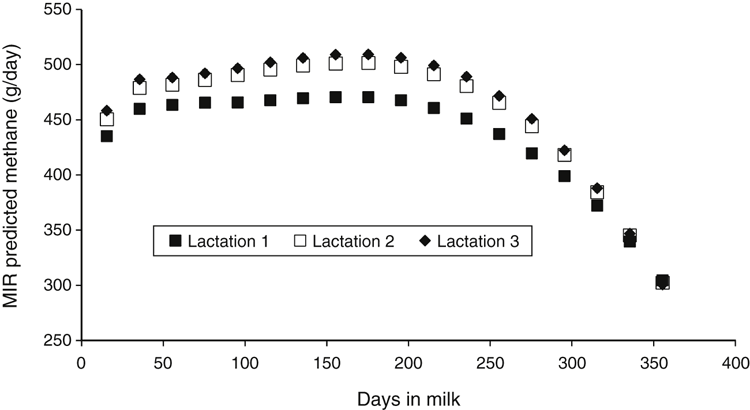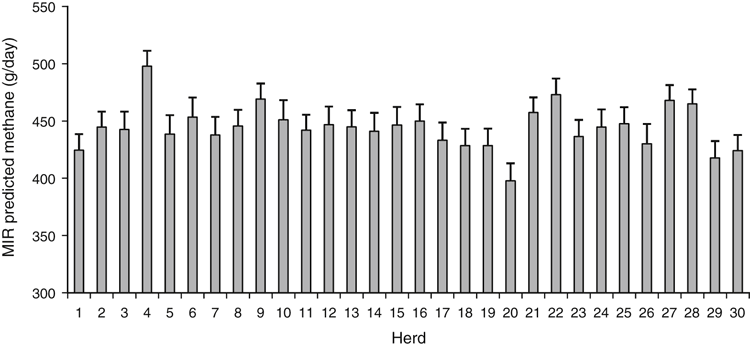Milk mid-infrared spectra enable prediction of lactation-stage-dependent methane emissions of dairy cattle within routine population-scale milk recording schemes
Amélie Vanlierde A , Marie-Laure Vanrobays B G , Nicolas Gengler B , Pierre Dardenne A , Eric Froidmont C , Hélène Soyeurt B , Sinead McParland D , Eva Lewis D , Matthew H. Deighton D E , Michaël Mathot F and Frédéric Dehareng AA Walloon Agricultural Research Centre, Valorisation of Agricultural Products Department, Chaussée de Namur, 24, B-5030 Gembloux, Belgium.
B University of Liege – Gembloux Agro-Bio Tech, Agriculture, Bio-engineering and Chemistry Department, Passage des Déportés, 2, B-5030 Gembloux, Belgium.
C Walloon Agricultural Research Centre, Production and Sectors Department, Rue de Liroux, 8, B-5030 Gembloux, Belgium.
D Animal and Grassland Research and Innovation Centre, Teagasc, Moorepark, Fermoy, Co. Cork, Ireland.
E Agriculture Research Division, Department of Economic Development, Jobs, Transport and Resources, Ellinbank Centre, Ellinbank, Vic. 3821, Australia.
F Walloon Agricultural Research Centre, Department of Agriculture and Natural Environment, Rue de Serpont, 100, B-5030 Libramont, Belgium.
G Corresponding author. Email: mlvanrobays@ulg.ac.be
Animal Production Science 56(3) 258-264 https://doi.org/10.1071/AN15590
Submitted: 15 September 2015 Accepted: 24 November 2015 Published: 9 February 2016
Journal Compilation © CSIRO Publishing 2016 Open Access CC BY-NC-ND
Abstract
Mitigating the proportion of energy intake lost as methane could improve the sustainability and profitability of dairy production. As widespread measurement of methane emissions is precluded by current in vivo methods, the development of an easily measured proxy is desirable. An equation has been developed to predict methane from the mid-infrared (MIR) spectra of milk within routine milk-recording programs. The main goals of this study were to improve the prediction equation for methane emissions from milk MIR spectra and to illustrate its already available usefulness as a high throughput phenotypic screening tool. A total of 532 methane measurements considered as reference data (430 ± 129 g of methane/day) linked with milk MIR spectra were obtained from 165 cows using the SF6 technique. A first derivative was applied to the MIR spectra. Constant (P0), linear (P1) and quadratic (P2) modified Legendre polynomials were computed from each cows stage of lactation (days in milk), at the day of SF6 methane measurement. The calibration model was developed using a modified partial least-squares regression on first derivative MIR data points × P0, first derivative MIR data points × P1, and first derivative MIR data points × P2 as variables. The MIR-predicted methane emissions (g/day) showed a calibration coefficient of determination of 0.74, a cross-validation coefficient of determination of 0.70 and a standard error of calibration of 66 g/day. When applied to milk MIR spectra recorded in the Walloon Region of Belgium (≈2 000 000 records), this equation was useful to study lactational, annual, seasonal, and regional methane emissions. We conclude that milk MIR spectra has potential to be used to conduct high throughput screening of lactating dairy cattle for methane emissions. The data generated enable monitoring of methane emissions and production characteristics across and within herds. Milk MIR spectra could now be used for widespread screening of dairy herds in order to develop management and genetic selection tools to reduce methane emissions.
Additional keywords: breeding, management, methane prediction.
Introduction
Methane naturally emitted by dairy cows during anaerobic fermentation of feed is a significant greenhouse gas (Gerber et al. 2013). In addition the loss of energy as methane reduces the availability of consumed energy for the cow (Johnson and Johnson 1995). Hence, mitigating methane emissions could improve sustainability and profitability of dairy production. Factors governing the natural emission of methane from dairy cows include: diet composition (e.g. fibre, starch and lipid content), management of the herd (e.g. grassland access; Beauchemin et al. 2008) and genetics (some animals are more efficient than others and methane emissions seem to be heritable; e.g. Pickering et al. 2015). Recently, highly efficacious inhibitors of methanogenesis have also been developed (e.g. Hristov et al. 2015), which can be expected to further increase variability in methane emissions between cows and herds. Current methods to determine in vivo methane emissions (e.g. chamber, tracer gas and spot sampling techniques) are expensive and difficult to carry out on a large scale. For this reason, these direct measurement methods are unsuitable to examine the aetiology of methane emissions at a population scale. For that purpose the development of an easily measured proxy of methane emissions is desirable.
An equation has been developed to predict methane emissions from the mid-infrared (MIR) spectra of milk while accounting for lactation stage of cows (Vanlierde et al. 2015). This prediction equation could be very useful as a high throughput phenotypic screening tool within routine milk-recording programs to easily generate methane data and to undertake studies of methane emissions within- and between herds. However, accuracy and robustness of this equation can still be improved by the inclusion of new data in the calibration set to cover more variability (Vanlierde et al. 2015). This study was conducted to improve methane prediction from milk MIR spectra and to demonstrate the usefulness of the improved equation by applying it to the Walloon spectral database.
Materials and methods
Improvement of the methane prediction equation using lactation-stage-dependent coefficients to consider the expected metabolic status of cows
The initial equation developed in order to predict methane emissions was solely from milk MIR spectra (Dehareng et al. 2012). However, when applied to spectral data from the Walloon milk recording database, the resulting predictions of methane emissions throughout lactation (i.e. decreasing in early lactation and increasing thereafter) did not fit with the pattern expected from the literature (i.e. increasing in early lactation and decreasing thereafter; Garnsworthy et al. 2012). The initial equation was improved by replacing fixed coefficients by lactation-stage-dependent coefficients based on the use of modified Legendre polynomials (Gengler et al. 1999; Vanlierde et al. 2015). This development was based on the hypothesis that the relationship between methane emissions arising from fermentation of feed and milk MIR spectra, (which indirectly represents composition of milk) established through the equation of Dehareng et al. (2012) is also influenced by the products of fermentation processes (i.e. fatty acids; FA). Milk FA composition is dependent on the stage of lactation as rates of body tissue mobilisation differ. This strongly influences the synthesis of the different milk FA and their relative proportion in milk (Bastin et al. 2011). Changes in milk FA composition can be expected to influence the relationship between methane emissions and milk MIR spectra. For this reason, including stage of lactation in the equation enables consideration of the expected metabolic status of cows throughout lactation and was expected to improve the accuracy and robustness of the prediction (Vanlierde et al. 2015).
Reference data
A total of 532 daily methane emissions measurements with corresponding daily milk MIR spectra were obtained from 165 cows using the SF6 technique and the Fourier transform MIR spectrophotometer. Daily methane emissions within this reference dataset ranged from 180 to 802 g/day with an average ± s.d. of 430 ± 129 g/day. The reference data were highly variable, comprising data from: (1) different diets: classic barn diet with or without linseed supplement, with maize silage or fresh grass making up the greatest portion of the diet; total mixed ration; maize silage morning ration with a fibrous (straw, grass silage) evening ration; or full grazing; (2) cows of different breeds from different countries: 268 observations of Holstein cows in Belgium and 264 observations of Holstein, Jersey and Holstein × Jersey crossbred cows in Ireland; (3) different lactation parities (64 first, 43 second, 58 third or greater) and (4) different stages of lactation (18–322 days in milk). The 532 reference samples include 86 additional samples to those used by Vanlierde et al. (2015). The 86 additional samples were collected in Belgium from four different commercial farms and contribute more variability to the calibration equation through the addition of 18 new cows, four new farms and their particular management and diet systems. Moreover, those cows have been chosen particularly to have a better coverage of the entire lactation in the calibration dataset (Table 1). Indeed, Vanlierde et al. (2015) showed that for the previous version of the equation there was a lack of data at the very beginning and the end of the lactation especially for Belgian data.
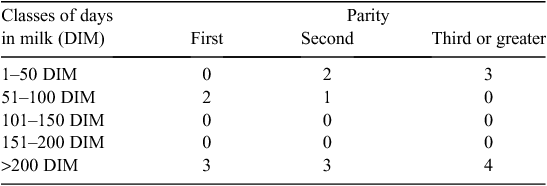
|
Calibration process
A first derivative was applied to the milk MIR spectra. The calibration was developed from three spectral regions: between wavelengths 968 and 1577 cm−1; 1720 and 1809 cm−1; and 2561 and 2966 cm−1 (n = 289 data points). Constant (P0), linear (P1) and quadratic (P2) modified Legendre polynomials were computed from cows days in milk at the day of methane measurement (Gengler et al. 1999) to take account of the expected metabolic status of cows. In this case Eqn 1:

where  and P0, P1, and P2 were the Legendre polynomials of first, second and third order, respectively.
and P0, P1, and P2 were the Legendre polynomials of first, second and third order, respectively.
The calibration model was developed using first derivative MIR data points at considered wavelength × P0, first derivative MIR data points × P1, first derivative MIR data points × P2. The final modified spectra were based on 3 × 289 data points (867 data points). A modified partial least square regression strategy as implemented in the WINISI software (Foss, Hillerød, Denmark) was used.
To test the robustness of the calibration model, a five-groups cross-validation was done: reference data were divided randomly into five groups, five calibration models were developed by removing each time one group that is predicted by the four others.
Application of equation to milk spectra
Predictions of methane emissions were obtained by applying the prediction equation to milk MIR spectra collected between January 2007 and January 2015 from 1675 herds in the Walloon Region of Belgium. Only spectra collected between 5 and 365 days in milk were kept. To discard spectra too spectrally different from spectra used for the calibration process, standardised Mahalanobis distance (global H distance; GH) between each spectra and spectra used for the calibration was calculated and spectra with a GH value greater than 3 were deleted from this study (e.g. Shenk and Westerhaus 1991; Soyeurt et al. 2012). Methane prediction lower than 150 g/day and higher than 950 g/day were considered as outliers (Vanlierde et al. 2015) and were excluded from this study (0.07% of the 2 049 366 spectra with a GH value lower than 3). A total of 2 047 893 MIR spectra were used from 145 249; 122 861; and 86 725 Holstein cows in first, second or third lactation, respectively. The methane prediction equation was applied to these spectra along with the lactation stage of the cows. Descriptive statistics were developed based on these predictions in order to demonstrate the usefulness of the methane prediction equation.
Results and discussion
Predicted methane emissions
The predicted methane emissions (g/day) obtained with the equation based on 532 reference data [versus those obtained with the one based on 446 reference data (Vanlierde et al. 2015)] had a calibration coefficient of determination (R2c) of 0.74 (vs 0.75), a cross-validation coefficient of determination (R2cv) of 0.70 (vs 0.67), a standard error of calibration (SEC) of 66 g/day (vs 63) and a standard error of cross-validation (SECV) of 70 g/day (vs 73). The predicted methane values ranged from 168 to 715 g/day with an average ± s.d. of 430 ± 111 g/day (vs 415 ± 127 g/day), which was similar to the reference values. The statistical results between the two versions of the equation are similar; however, the new equation is more robust as evidenced by the smaller difference between R2c and R2cv of the new equation as well as a smaller difference between SEC and SECV.
The relationship between predicted and measured methane emissions is shown in Fig. 1. It is clear from the linear relationship that MIR prediction was highly correlated with actual methane emissions and that it is possible to identify cows with high or low daily emissions. However, the accuracy and robustness of this prediction equation could be further enhanced by the addition of new reference values (i.e. methane measurements and milk MIR spectra with variability not already included in the model). Such new reference values should be added to the calibration dataset to increase coverage of population variability.
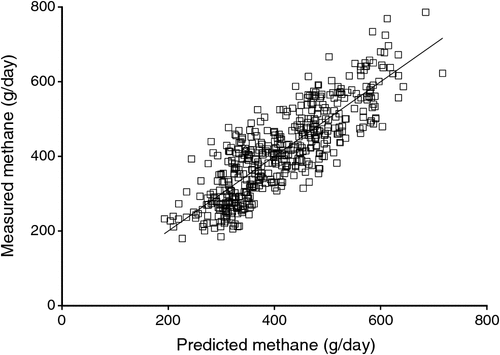
|
Prediction of methane emissions
The developed prediction equation for methane emissions was applied to milk MIR spectra to demonstrate its potential usefulness. The proportion of spectra with GH values higher than 3 excluded from the spectral database was lower compared with that obtained by Vanlierde et al. (2015; 5% vs 14%, respectively), indicating that robustness of the prediction equation was improved in this study by covering more spectral and methane variabilities. Averages ± s.d. of methane predictions were 443 ± 69 g/day, 468 ± 74 g/day, and 475 ± 75 g/day for cows in first, second, and third lactation, respectively. As expected, multiparous cows had greater emissions than primiparous cows. The quantity of feed eaten has a large influence on methane emissions (e.g. Pickering et al. 2015) and on average the feed intake of multiparous cows is greater than primiparous cows. Predictions of average daily methane emissions throughout lactation are shown in Fig. 2.
Predicted methane emissions showed increasing values from the beginning of lactation until ~100 days in milk and then decreasing values from 200 days in milk until the end of lactation as expected (e.g. Garnsworthy et al. 2012). As found for averages of methane predictions, the change in predicted methane emissions during lactation was less for cows in first lactation compared with cows in second and third lactation. Based on methane predictions, seasonal variation (e.g. monthly and yearly) of average methane emissions were also studied. Predicted methane emissions were on average lower during the summer season compared with other seasons although there were less data in July (Fig. 3). This decrease in predicted methane emissions could be explained by a decrease in feed intake when temperature increases during summer (Hammami et al. 2015) and also because the majority of dairy cows in the Walloon Region of Belgium are outdoors grazing in the summer period. In general, dry matter intake of grass-fed cows is expected to be lower compared with cows fed with a total mixed ration (Robertson and Waghorn 2002) leading to a decrease of methane emissions (O’Neill et al. 2011) because dry matter intake represents the main driver of methane production (Hegarty et al. 2007). The majority of cows used in this study calved during autumn (36% of cows calved in September, October, or November). Therefore, the observed decrease in predicted daily methane emissions during the summer period could also be due to a decrease in feed intake, which commonly occurs at the end of lactation (Zom et al. 2012). Predicted daily methane emissions also differed between years (Fig. 4). On average, cows produced less methane from 2011 to 2014 than earlier years. Many factors could explain these differences such as variation of temperature, quality of forage, and different animals. Further investigations are needed to have a better understanding of these differences. The same trends observed in Fig. 3 and Fig. 4 (i.e. lower methane production during summer and from 2011 to 2014) are shown in Fig. 5 although amplitudes of variation differ by month and year.
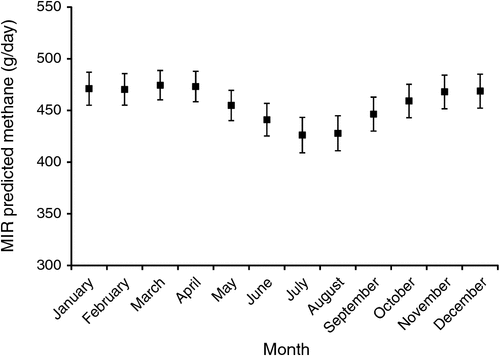
|
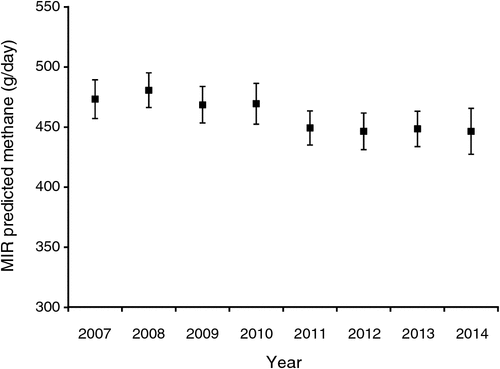
|
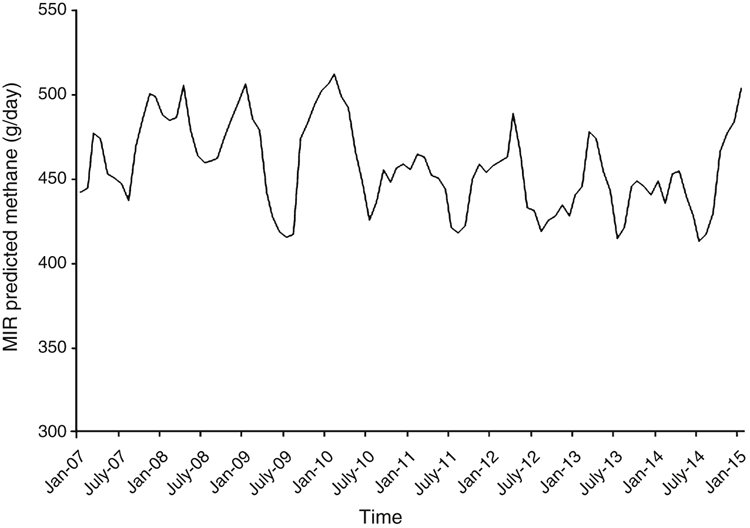
|
Regional differences in methane emissions of dairy cows were also identified. The two most extreme differences, considering a period of 7 years (from August 2007 to December 2014), were found between the average daily methane emissions of cows located in the town of Doische within the region of the Province of Namur was 422 ± 74 g/day to the cows located in the town of Attert within the region of the Province of Luxembourg emitting 482 ± 68 g/day on average. Without more detailed information from the field the increased daily methane emissions of the cows from this town in the Province of Luxembourg region cannot yet be precisely explained. However, the standard deviations of average daily methane emissions were in the same range as the SECV of the prediction equation.
Thanks to this tool and some of these descriptive statistics, management strategies aimed at reducing methane emissions or increasing the feed conversion efficiency of dairy cows could be developed. Indeed, MIR spectra could be routinely recorded within milk-recording schemes (Friedrichs et al. 2015) allowing large-scale prediction of methane emissions. Screening of cows’ methane emissions between herds could be performed. Predictions of methane emitted by cows could be also evaluated within a herd. For example, the daily methane emissions predicted from milk MIR spectra throughout lactation for two cows within the same herd is shown in Fig. 6. Differences between methane predictions of these cows could be explained by different factors. One of these factors should be the calving season. Indeed, cow A calved during autumn whereas cow B calved during spring. Therefore, peak lactation for cow B occurred at the beginning of summer following, which the feed intake of cow B was expected to decrease and this feed intake decrease should lead to a decrease in methane emissions. In comparison, peak lactation for cow A occurred during winter with no decrease of feed intake expected. A comparison between the average predicted methane emissions of first lactation cows in 30 Walloon herds with relative standard deviation is shown in Fig. 7. Huge differences of average predicted methane emissions between these herds could be observed. These differences between herds could be related to herd characteristics such as diet composition and management. Further investigations are needed to explain these differences.
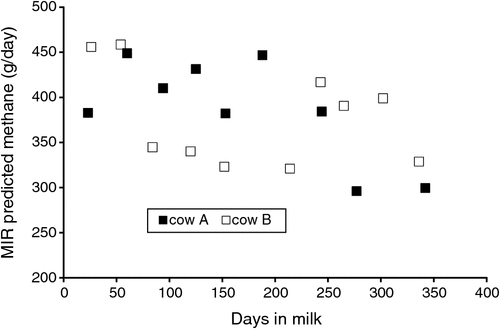
|
Milk MIR spectroscopy now provides a very powerful, low cost and high throughput (population scale) screening method to identify cows within national herds that display a low methane emissions phenotype. The identification of genetic markers common to these animals could enable genetic or genomic selection for reduced enteric methane emissions. Such breeding objectives are desirable as methane emissions represent a substantial economic loss of dietary energy, and this trait appears to be variable and heritable (e.g. Pickering et al. 2015). Genetic correlations of methane emissions with other traits of interest such as milk, fat and protein yield, could be estimated simultaneously as MIR spectra are recorded within milk-recording schemes.
Conclusions
The prediction of daily methane emissions of dairy cows using MIR spectrometry analysis that could be already available in routine within milk recording represents a powerful and low cost tool to compare methane emissions between cows, herds, years, diets and management practices. Cows with high milk production and low methane emissions could be distinguished. And there are many more applications of this tool. However, additional methane measurements are needed in the calibration dataset to improve accuracy and robustness of this tool. Moreover, through application of the technology we have developed, other investigations should be achieved in order to have a better understanding of the parameters which influence enteric methane emissions and genetic selection could be undertaken while taking into account other important production parameters such as milk yield, fertility, and efficiency. Inclusion of MIR-derived methane emissions traits in genetic selection indices is expected to result in an incremental and permanent improvement in milk production efficiency and greenhouse gas emissions over time.
Acknowledgements
Financial support was provided by the Ministry of Agriculture of Walloon Region of Belgium (Service Public de Wallonie, Direction générale opérationnelle ‘Agriculture, Ressources naturelles et Environnement’ – DGARNE) through research projects D31–1248 and D31–1304. Nicolas Gengler, as a former senior research associate, acknowledges the support of the National Fund for Scientific Research (Brussels, Belgium). The authors thank the other Walloon Futurospectre partners, the Walloon Breeding Association (Ciney, Belgium) for providing access to data related to the Walloon milk recording and the milk laboratory ‘Comité du Lait’ (Battice, Belgium) for providing spectral data. Frédéric Colinet (Gembloux Agro-Bio Tech, University of Liège, Gembloux, Belgium) is acknowledged for providing programs to calculate standardised Mahalanobis distances. Computational resources have been provided by the Consortium des Équipements de Calcul Intensif (CÉCI), funded by the National Fund for Scientific Research (Brussels, Belgium) under Grant No. 2.5020.11. The authors also acknowledge the support provided by the European Commission under the Seventh Framework Program for the GreenhouseMilk and GplusE projects, Grant Agreements FP7-PEOPLE-ITN-2008 238562 and FP7-KBBE-613689, and the contribution of the COST Action FA1302 Methagene (http://www.methagene.eu). The content of the paper reflects only the view of the authors; the Community is not liable for any use that may be made of the information contained in this publication.
References
Bastin C, Gengler N, Soyeurt H (2011) Phenotypic and genetic variability of production traits and milk fatty acid contents across days in milk for Walloon Holstein first-parity cows. Journal of Dairy Science 94, 4152–4163.| Phenotypic and genetic variability of production traits and milk fatty acid contents across days in milk for Walloon Holstein first-parity cows.Crossref | GoogleScholarGoogle Scholar | 1:CAS:528:DC%2BC3MXpsVylu7w%3D&md5=7e8f1b8174b99a2c18817553923efb8cCAS | 21787950PubMed |
Beauchemin KA, Kreuzer M, O’Mara F, McAllister TA (2008) Nutritional management for enteric methane abatement: A review. Australian Journal of Experimental Agriculture 48, 21–27.
| Nutritional management for enteric methane abatement: A review.Crossref | GoogleScholarGoogle Scholar | 1:CAS:528:DC%2BD1cXovVGn&md5=23b38df440406cdf954ea8c1fc39bac0CAS |
Dehareng F, Delfosse C, Froidmont E, Soyeurt H, Martin C, Gengler N, Vanlierde A, Dardenne P (2012) Potential use of milk mid-infrared spectra to predict individual methane emission of dairy cows. Animal 6, 1694–1701.
| Potential use of milk mid-infrared spectra to predict individual methane emission of dairy cows.Crossref | GoogleScholarGoogle Scholar | 1:CAS:528:DC%2BC38Xht1Gis7zP&md5=4aa34f19d46bf8fcba0ccfb516a8a24eCAS | 23031566PubMed |
Friedrichs P, Bastin C, Dehareng F, Wickham B, Massart X (2015) Final OptiMIR Scientific and Expert Meeting: from milk analysis to advisory tools (Palais des Congrès, Namur, Belgium, 16–17 April 2015). Biotechnologie, Agronomie, Société et Environnement 19, 97–124. http://www.pressesagro.be/base/index.php/base/article/view/1152
Garnsworthy PC, Craigon J, Hernandez-Medrano JH, Saunders N (2012) Variation among individual dairy cows in methane measurements made on farm during milking. Journal of Dairy Science 95, 3181–3189.
| Variation among individual dairy cows in methane measurements made on farm during milking.Crossref | GoogleScholarGoogle Scholar | 1:CAS:528:DC%2BC38Xntlyksbk%3D&md5=6c6728c6d63911fc60254356b4774721CAS | 22612953PubMed |
Gengler N, Tijani A, Wiggans GR, Misztal I (1999) Estimation of (Co)variance function coefficients for test day yield with a expectation-maximization restricted maximum likelihood algorithm. Journal of Dairy Science 82, 1849.e1–1849.e23.
| Estimation of (Co)variance function coefficients for test day yield with a expectation-maximization restricted maximum likelihood algorithm.Crossref | GoogleScholarGoogle Scholar |
Gerber PJ, Steinfeld H, Henderson B, Mottet A, Opio C, Dijkman J, Falcucci A, Tempio G (2013) ‘Tackling climate change through livestock: a global assessment of emissions and mitigation opportunities.’ (Food and Agriculture Organization of the United Nations (FAO): Rome, Italy)
Hammami H, Vandenplas J, Vanrobays M-L, Rekik B, Bastin C, Gengler N (2015) Genetic analysis of heat stress effects on yield traits, udder health, and fatty acids of Walloon Holstein cows. Journal of Dairy Science 98, 4956–4968.
| Genetic analysis of heat stress effects on yield traits, udder health, and fatty acids of Walloon Holstein cows.Crossref | GoogleScholarGoogle Scholar | 1:CAS:528:DC%2BC2MXotVWhu70%3D&md5=720944730ec1ea0175ec5fc416a1b284CAS | 25958288PubMed |
Hegarty RS, Goopy JP, Herd RM, McCorkell B (2007) Cattle selected for lower residual feed intake have reduced daily methane production. Journal of Animal Science 85, 1479–1486.
| Cattle selected for lower residual feed intake have reduced daily methane production.Crossref | GoogleScholarGoogle Scholar | 1:CAS:528:DC%2BD2sXls1ant7c%3D&md5=8004943b5c2eb95bd7a3c31248e24898CAS | 17296777PubMed |
Hristov A, Oh J, Giallongo F, Frederick T, Harper M, Weeks H, Branco A, Moate P, Deighton M, Williams S, Kindermann M, Duval S (2015) An inhibitor persistantly decreased enteric methane emission from dairy cows with no negative effect on milk production. Proceedings of the National Academy of Sciences of the United States of America 112, 10663–10668.
| An inhibitor persistantly decreased enteric methane emission from dairy cows with no negative effect on milk production.Crossref | GoogleScholarGoogle Scholar | 1:CAS:528:DC%2BC2MXht1GrsL3P&md5=1c3d9175995aea8695a264f3f1772926CAS | 26229078PubMed |
Johnson KA, Johnson DE (1995) Methane emissions from cattle. Journal of Animal Science 73, 2483–2492.
| Methane emissions from cattle.Crossref | GoogleScholarGoogle Scholar | 1:CAS:528:DyaK2MXnsVCntb8%3D&md5=4357890dcfe011b84b6b72819b5c1810CAS | 8567486PubMed |
O’Neill BF, Deighton MH, O’Loughlin BM, Mulligan FJ, Boland TM, O’Donovan M, Lewis E (2011) Effects of a perennial ryegrass diet or total mixed ration diet offered to spring-calving Holstein-Friesian dairy cows on methane emissions, dry matter intake, and milk production. Journal of Dairy Science 94, 1941–1951.
| Effects of a perennial ryegrass diet or total mixed ration diet offered to spring-calving Holstein-Friesian dairy cows on methane emissions, dry matter intake, and milk production.Crossref | GoogleScholarGoogle Scholar | 1:CAS:528:DC%2BC3MXnvFChtbg%3D&md5=a2f73a1b3b8cbc422ca6d51cf22dcbcdCAS | 21426985PubMed |
Pickering NK, Oddy VH, Basarab J, Cammack K, Hayes B, Hegarty RS, Lassen J, McEwan JC, Miller S, Pinares-Patiño CS, de Haas Y (2015) Animal board invited review: genetic possibilities to reduce enteric methane emissions from ruminants. Animal 9, 1431–1440.
| Animal board invited review: genetic possibilities to reduce enteric methane emissions from ruminants.Crossref | GoogleScholarGoogle Scholar | 1:CAS:528:DC%2BC2MXhtlOnurnN&md5=e528453b2c769598a2e2d1ca33f314efCAS | 26055577PubMed |
Robertson L, Waghorn G (2002) Dairy industry perspectives of methane emissions and production from cattle fed pasture or total mixed rations in New Zealand. In ‘Proceedings of the New Zealand Society of Animal Production’. Volume 62. pp. 213–218. (New Zealand Society of Animal Production: Palmerston North, New Zealand)
Shenk JS, Westerhaus MO (1991) Population definition, sample selection, and calibration procedures for near infrared reflectance spectroscopy. Crop Science 31, 469–474.
| Population definition, sample selection, and calibration procedures for near infrared reflectance spectroscopy.Crossref | GoogleScholarGoogle Scholar |
Soyeurt H, Bastin C, Colinet FG, Arnould VM-R, Berry DP, Wall E, Dehareng F, Nguyen HN, Dardenne P, Schefers J, Vandenplas J, Weigel K, Coffey M, Théron L, Detilleux J, Reding E, Gengler N, McParland S (2012) Mid-infrared prediction of lactoferrin content in bovine milk: potential indicator of mastitis. Animal 6, 1830–1838.
| Mid-infrared prediction of lactoferrin content in bovine milk: potential indicator of mastitis.Crossref | GoogleScholarGoogle Scholar | 1:CAS:528:DC%2BC38XhsVKltL3F&md5=f94c3af49fc3d0ec72f5c743fa0d4ff0CAS | 22717388PubMed |
Vanlierde A, Vanrobays M-L, Dehareng F, Froidmont E, Soyeurt H, McParland S, Lewis E, Deighton MH, Grandl F, Kreuzer M, Gredler B, Dardenne P, Gengler N (2015) Hot Topic: Innovative lactation stage dependent prediction of methane emissions from milk mid-infrared spectra. Journal of Dairy Science
| Hot Topic: Innovative lactation stage dependent prediction of methane emissions from milk mid-infrared spectra.Crossref | GoogleScholarGoogle Scholar | 26026761PubMed |
Zom RLG, André G, van Vuuren AM (2012) Development of a model for the prediction of feed intake by dairy cows: 1. Prediction of feed intake. Livestock Science 143, 43–57.
| Development of a model for the prediction of feed intake by dairy cows: 1. Prediction of feed intake.Crossref | GoogleScholarGoogle Scholar |
*These authors contributed equally to this work.


